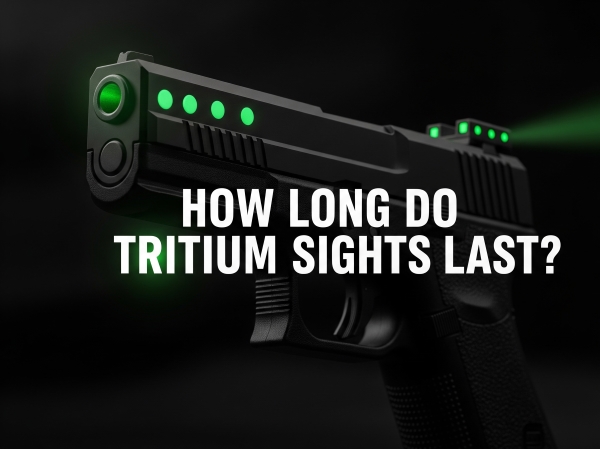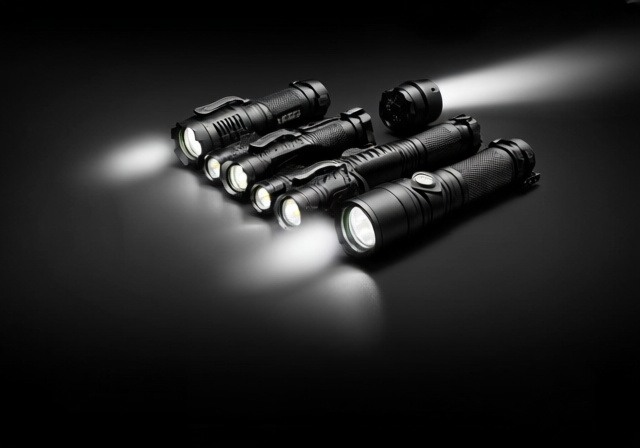



If you’re relying on tritium night sights for low-light shooting, you’ve probably wondered when they’ll start to fade. I’ve spent years tracking the performance of tritium sights across different brands, and the answer involves both precise science and practical experience.
Here’s the scientific reality: tritium has a half-life of exactly 12.32 ± 0.02 years according to the National Institute of Standards and Technology (NIST). This means your sights lose half their brightness every 12.3 years. But what does this actually mean for your shooting?
Most tritium sights remain effectively bright for 10-12 years, with noticeable dimming starting around year 8. After 12 years, they’ll be at 50% brightness, and by year 24, they’ll be at just 25% of their original output. While they never completely stop glowing, they become too dim for practical use somewhere between 12-15 years.
Tritium (³H) is a radioactive isotope of hydrogen that undergoes beta decay, releasing electrons that excite phosphor coatings inside your sight vials. This creates the characteristic glow without requiring batteries or charging.
The decay follows an exponential curve described by the equation: N(t) = N₀ × e^(-λt), where λ = 0.693/t₁/₂. For tritium’s 12.32-year half-life, this means:
What’s crucial to understand is that this decay starts the moment tritium is sealed in the vial at the factory, not when you purchase the sight. A sight that sat in inventory for two years before you bought it is already at 89% brightness when you install it.
While the physics is straightforward, practical replacement timing depends on your use case. Law enforcement agencies typically replace tritium sights every 5-7 years to maintain maximum visibility in critical situations. Competition shooters often wait 8-10 years, while casual users might stretch to 12-15 years.
I’ve tracked dozens of tritium sights over the years, and here’s what actually happens:
Years 0-5: The brightness decrease is barely noticeable. Your sights still pop in complete darkness and transition lighting. Green tritium maintains its visibility best during this period.
Years 5-8: You’ll notice slight dimming in pitch-black conditions, but the sights remain fully functional. Orange and yellow tritium may appear noticeably dimmer than green at this stage.
Years 8-12: The dimming becomes obvious, especially when comparing to new sights. They still work in most low-light scenarios but struggle in true darkness. This is when most users start considering replacement.
Years 12-15: At 50% brightness or less, the sights become marginal. They’re visible in complete darkness if you look for them, but quick target acquisition becomes difficult.
Beyond 15 years: While still technically glowing, the sights are too dim for practical use. At this point, they’re essentially standard iron sights.
Understanding manufacturer warranties gives you insight into expected lifespan. Here’s what major brands offer:
Trijicon: The industry leader provides a 12-year limited warranty on green and yellow tritium, but only 5 years on orange tritium. This reflects the actual decay rates of different phosphor coatings.
Meprolight: Offers a 12-year warranty on all tritium colors, though they note that brightness will decrease over time as expected.
TruGlo: Provides a 12-year warranty on their TFX and TFO series, matching the tritium half-life.
XS Sights: Warranties their tritium for 10 years, slightly conservative compared to others.
Night Fision: Offers a 12-year tritium warranty with the caveat that normal decay is expected.
These warranties typically cover manufacturing defects and premature dimming, not normal radioactive decay. If your sights fail completely within the warranty period, that’s a defect. But gradual dimming over 12 years is considered normal.
While radioactive decay is constant, several factors can affect the perceived lifespan of your tritium sights:
Extreme temperatures don’t affect the tritium decay rate, but they can damage the sight housing and seals. Repeated exposure to temperatures above 140°F or below -40°F can cause vial failure, leading to tritium leakage and immediate sight failure.
The glass vials containing tritium are surprisingly durable but not indestructible. A hard impact can crack the vial, allowing tritium gas to escape. Once breached, the sight stops glowing immediately.
The phosphor coating that converts beta radiation to visible light can degrade independently of tritium decay. Lower-quality phosphors may yellow or lose efficiency over time, making sights appear dimmer than tritium decay alone would predict.
Manufacturers can vary the initial tritium pressure in vials. Higher-pressure fills start brighter but decay at the same rate, meaning they stay usable longer. Premium sights often use maximum legal tritium fills.
While storage doesn’t affect decay rate, UV exposure can degrade phosphor coatings and housing materials. Sights stored in direct sunlight may fail prematurely due to material degradation, not tritium issues.
The decision to replace tritium sights depends on your specific needs and risk tolerance. Here’s my replacement timeline based on use case:
Duty/Defense Use (5-7 years): If your life depends on these sights, replace them when they reach 60-70% brightness. You need maximum visibility in critical situations.
Competition Shooting (8-10 years): Replace when consistency becomes an issue, typically around 50-60% brightness. Mismatched front and rear sight brightness can affect accuracy.
Hunting (10-12 years): Most hunters can wait until sights reach 40-50% brightness. Dawn and dusk shooting still works at these levels.
Range/Recreational (12-15 years): If you primarily shoot in good lighting, you can maximize the lifespan. Replace when they no longer provide any low-light advantage.
A practical test: Take your firearm into a completely dark room after your eyes adjust for 5 minutes. If you can’t immediately acquire the sights, it’s time for replacement.
When your tritium sights dim, you have three options: replace the entire sight set, use a relamping service, or upgrade to newer technology.
New tritium sight sets range from $50 to $200, with professional installation adding $30-80. Over a 12-year lifespan, this works out to $8-15 per year. Benefits include:
Some companies offer relamping for $40-60 per sight set, where they replace the tritium vials in your existing sights. This saves money but has limitations:
Consider upgrading to hybrid tritium/fiber optic sights ($80-150) or LED sights ($150-300). These offer:
Calculate your actual cost per year of use. If you got 10 years from $100 sights, that’s $10 per year – less than a box of practice ammunition.
While you can’t stop radioactive decay, proper care ensures your sights last their full expected lifespan:
Use quality holsters that protect sights from impacts. A cracked vial means immediate replacement regardless of age. Consider sight protectors during storage or transport.
Don’t leave firearms in hot vehicles or freezing conditions for extended periods. Temperature cycling can stress vial seals and housing materials.
Use non-abrasive cleaners and avoid harsh solvents near sight vials. Aggressive cleaning can damage seals or cloud the vial glass, reducing apparent brightness.
Check for cracks, cloudiness, or uneven glowing every few months. Early detection of problems prevents complete failure at critical moments.
Record when you bought and installed sights. This helps track warranty coverage and plan replacement timing. Include manufacture date if visible on packaging.
Keep firearms in controlled environments when possible. Avoid direct sunlight on sights during long-term storage, as UV can degrade materials.
Before assuming your sights need replacement due to age, check these common issues:
Uneven Brightness: If one sight is significantly dimmer, it may have a cracked vial or manufacturing defect. This warrants warranty claim if within coverage period.
Sudden Failure: Tritium doesn’t suddenly stop working due to decay. Complete failure indicates a cracked vial, requiring immediate replacement.
Cloudy Appearance: Vial glass can cloud from chemical exposure or age, reducing apparent brightness even with good tritium levels. This requires replacement.
Daylight Visibility Issues: If sights work in darkness but not daylight, the white outline paint may have worn off. This can sometimes be touched up without replacing the tritium.
Comparison Testing: Compare your sights to a known-age reference in complete darkness. This gives you an objective brightness assessment.
Tritium in intact sight vials poses no health risk. The beta particles it emits can’t penetrate the vial glass or your skin. Even if a vial breaks, the amount of tritium is far below dangerous levels.
The Nuclear Regulatory Commission (NRC) strictly regulates tritium in consumer products. Gun sights contain 15-25 millicuries of tritium, well below levels requiring special disposal. For perspective, you’d need to break and inhale the contents of hundreds of sight vials to approach harmful exposure.
That said, handle broken vials responsibly:
The radioactivity decreases with decay, so 12-year-old sights contain half the tritium of new ones, making them even less of a concern.
As tritium sights age, consider these advancing technologies:
These combine tritium vials with fiber optic rods, providing bright daylight visibility and tritium backup for darkness. Brands like TruGlo TFX and Meprolight FT Bullseye lead this category.
Battery-powered LED sights offer adjustable brightness and longer lifespan. The XS Sights DXT2 Big Dot with LED upgrade provides years of battery life with constant-on function.
Modern photoluminescent paints charge from ambient light and glow for hours. While not as long-lasting as tritium in complete darkness, they never expire and work well for most users.
Emerging technology using electroluminescent panels powered by tiny batteries. These offer decades of lifespan with replaceable power sources.
No, tritium decay is irreversible. Once the radioactive material decays, it’s gone forever. “Recharging” would require adding new tritium, which means replacing the vials entirely through professional relamping services.
The tritium itself decays at the same rate regardless of color, but different phosphor coatings affect perceived brightness. Green appears brightest to human eyes and maintains visibility longest. Orange and yellow may seem to fade faster despite identical tritium decay.
No, at 12 years they’re at 50% brightness and continue glowing at decreasing levels for decades. They never completely stop, but become too dim for practical use around 15-20 years.
Some manufacturers stamp date codes on packaging or sight bodies. Contact the manufacturer with your serial number if no date is visible. For warranty purposes, keep your purchase receipt as proof of acquisition date.
Generally no. At 10 years, they’re at 57% brightness with limited remaining lifespan. Unless heavily discounted (75% off or more), new sights provide better value.
Yes, radioactive decay continues normally at all temperatures. However, extreme cold can make the phosphor less efficient, causing slightly dimmer appearance that returns to normal when warmed.
No, the sealed vials maintain their own internal pressure. Neither altitude nor external air pressure affects tritium decay or brightness.
Yes, in the United States, tritium gun sights are exempt from NRC disposal regulations due to their low radioactivity. Check local regulations, but normal trash disposal is typically acceptable.
Understanding tritium sight lifespan helps you plan replacements before critical failures. The 12.32-year half-life means predictable brightness decrease, with practical lifespan ranging from 5-15 years depending on your needs.
For most users, I recommend replacement at 10-12 years when sights reach 50-60% brightness. This maximizes value while maintaining reliable low-light capability. Track your sight age, inspect regularly, and budget for replacement as part of firearm maintenance.
Remember that gradual dimming is normal and expected – it’s physics, not a defect. Plan ahead, and you’ll never be caught with dim sights when you need them most. Whether you choose traditional tritium, hybrid systems, or newer technologies for replacement, understanding the science helps you make informed decisions about your sight system.
The 2025 market offers excellent options at every price point, from basic tritium replacements to advanced hybrid systems. Choose based on your use case, budget, and how long you plan to keep the firearm. With proper planning, you’ll always have bright, reliable sights when it matters.







